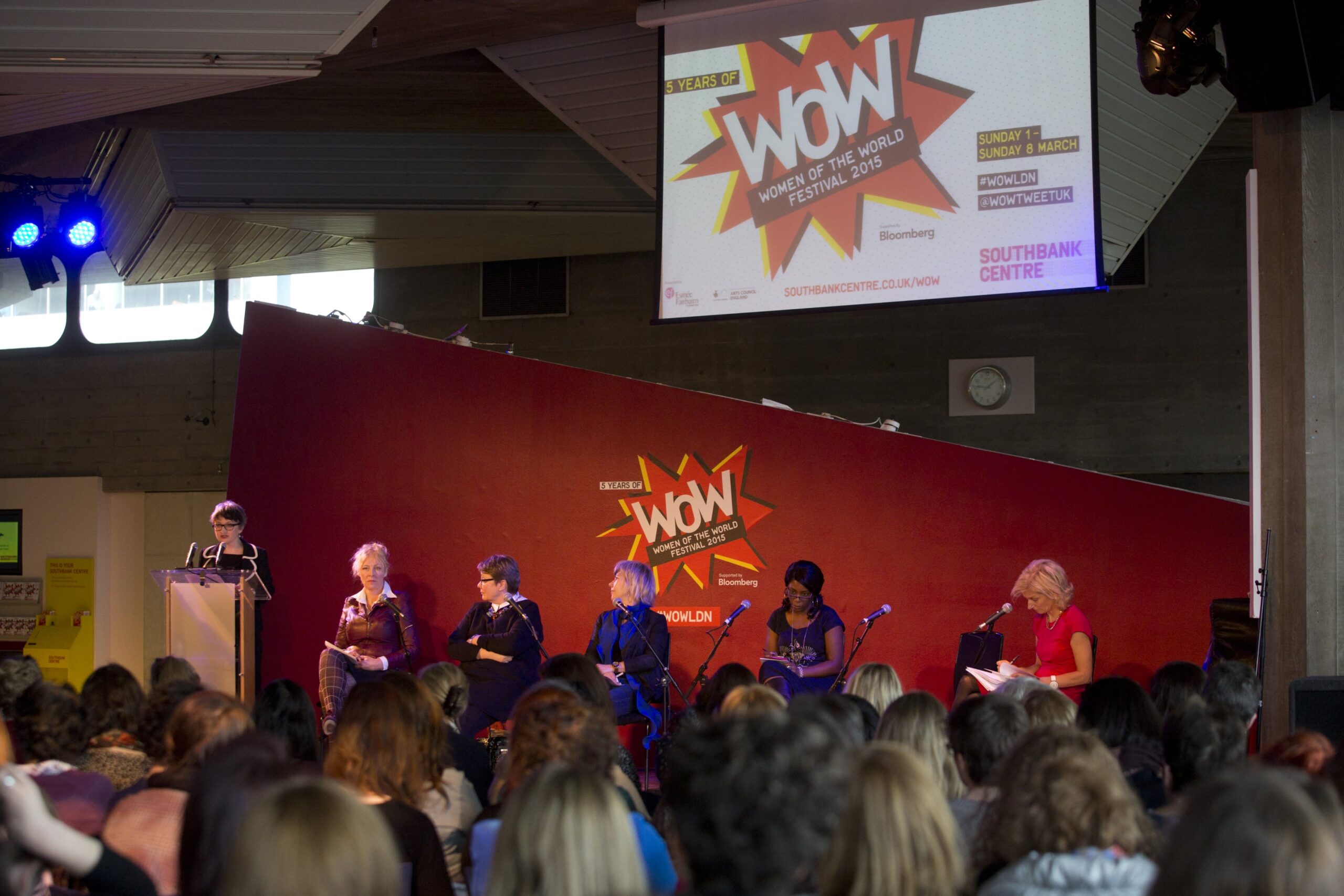
Speakers at the recent WOW conference at the Southbank Centre
Where are the women?
It’s time to face the truth: our cultural landscape is ‘man-made’. And the course of history won’t be corrected by women alone, says Jude Kelly.
I often feel sad when I survey the history of culture. Art is one of the central loves of my life, and yet as a woman it often makes me melancholy. I leaf through rich seasons of classical music, pass through the wonderful collections of our art galleries and museums, peruse the retrospectives of renowned film directors, the canon of performance and literature – and I feel sorrow that over thousands of years so very few females appear to have contributed to the formal act of creative expression that distinguishes humans from all other species.
I regularly speak around the world about the vital importance of the arts but I’m making this fierce assertion while noting how gender inequality in all our societies has marginalised women’s voices and still does so. It’s glaringly obvious in some places. Some customs and religions place the man as all powerful and so it’s not surprising that the senior practising artists, curators and writers are largely male. They assume that this is their birth right and that a woman’s role is to serve as the organisers and administrative helpmates at these artistic conventions, symposiums and editorial meetings. These gatherings serve to strengthen their argument for society’s need to respect and fund the makers of arts and culture without seeming to notice the paradox of suppressing a woman’s right to do that very thing.
Please don’t let future generations walk through cultural institutions and feel it is still a man-made landscape
But what about when I touch down back home, how does the cultural landscape appear? Well, there are definite signs of change for women in the arts over the last 50 years but it’s still not widespread enough, not quick enough and, worst of all, not recognised by some at senior level as even being a relevant issue. We are endlessly excited by poring over the undisputed genius of Shakespeare and Mozart, Da Vinci and Donne and then comparing them to Arthur Miller and Stravinsky, Picasso and TS Eliot. But the archiving and discovery of women’s work among our heritage is considered of niche interest. The deliberate promotion of female artists and curators through contemporary schemes and prizes is still scoffed at by some as just absurd political correctness and irritates others, including some women, who feel its patronising tokenism. The evidence shows very clearly that positive action makes a huge difference in giving women permission, time, space and, very importantly, money to make ambitious work; that role models past and present have a significant impact on personal confidence; and that the unconscious bias that all of us have towards the ‘expert’ in any public field being male is affected once female talent begins to be frequently and consistently acknowledged. (Anyone dealing directly with representation for BME or disability artists will also be all too familiar with the results of this bias. And, shockingly, it’s not always unconscious.)
I’m assuming everyone reading this believes in the power of the arts to elevate, provoke, restore, reflect and all the other words we summon to explain the ultimate mystery and fundamental import of cultural practice. But art doesn’t exist separate from the person who makes it and we constantly and rightly note that the more personal the expression the more truthful the work. If most of these expressions through history are from men, and therefore about the male experience, we are all underserved in understanding our shared world. Establishing the credibility and relevance of female expression is critical to the future canon and critical to men and women alike. Please don’t let future generations walk through cultural institutions and feel it is still a man-made landscape. Please don’t leave it just to women in the field to try to redress history as well as shaping the present and the future. That’s too lonely and I don’t think ultimately it’s possible unless it becomes a shared passion.
Last week a 21-year-old female choreographer came to see me to share the humiliation and outrage she felt on a recent project. She was one of 13 emerging artists meeting a male choreographer in his thirties for a masterclass. 11 of the cohort happened to be women, but she described the clear disappointment on his face when he encountered them and his remark “Oh! You’re mostly girls. What have you done with all the men?” Her shock at being instantly undervalued is reminiscent of stories I hear continually from young women conductors, visual artists, composers and directors (and this is not in Pakistan or the Gulf States but in our modern democracies where state funding accelerates opportunities unequally). I’d like all our granddaughters, grandnieces and future girls across the globe not to feel my sadness about the history of the arts. For that to happen, we all need to care.
Jude Kelly is Artistic Director of Southbank Centre.
wow.southbankcentre.co.uk
Join the Discussion
You must be logged in to post a comment.